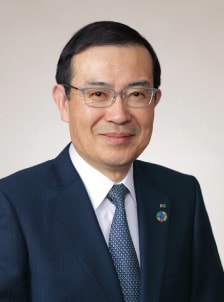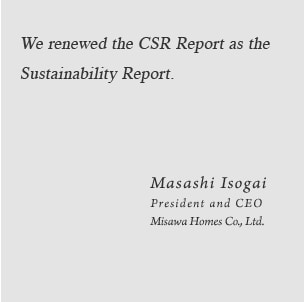

During fiscal 2019, ended March 31, 2019, Japan suffered various natural disasters, including a large earthquake in the northern Osaka in June, torrential rain mainly in western Japan in July, the Hokkaido Eastern Iburi Earthquake in September and repeated landfalls of major typhoons. These events caused significant damage as well as loss of lives. On behalf of the Misawa Homes Group, I send my prayers to the victims and extend our sincerest condolences to those who lost loved ones and pray that life in the areas affected by these natural disasters returns to normal as quickly as possible.
The Japanese economy was buffeted by winds of instability overseas, notably trade friction between China and the United States and political issues in Europe, which required careful watching, but overall conditions in Japan were favorable. The employment environment improved, personal incomes grew, government policies delivered positive results and a gradual recovery trend supported business conditions.
In the housing industry, demand for rental homes used to minimize the burden of inheritance taxes was down. However, interest rates on mortgages remained low, buoying housing starts up 0.7% year on year, to 950,000 units. At Misawa Homes, fiscal 2019 marked the second year of First Step For NEXT50, a medium-term management plan running from fiscal 2018 through fiscal 2020, and we focused efforts on “town-living solutions,” which are designed to realize a society in which no people have to leave their jobs to care for the elderly or raise children. As a result, although sales of single-family detached homes dropped slightly year on year, largely due to the impact of natural disasters, we managed to ensure higher sales and higher profits in fiscal 2019 thanks to favorable progress in the residential community development business, which includes condominium sales.
The government is promoting a policy encouraging the development of compact cities. To accommodate small sites for town living, we focused on product development fine-tuned to Goal 11 (Sustainable cities and communities) of the United Nations Sustainable Development Goals (SDGs). Our efforts included launches of CENTURY Primore3, a three-story urban-type dwelling with 120 mm thick wooden panels that used the CENTURY MONOCOQUE method, and MJ Wood wooden-frame homes with high earthquake resistance that feature building materials approved for fire-protection zones and a wide-opening carport big enough for two vehicles. Seeking to strengthen our presence in the large-scale remodeling and renovation market for non-residential buildings, we increased our stake in Daisue Construction Co., Ltd., turning it into an affiliate accounted for by the equity method. Going forward, we will use this alliance to strengthen our involvement in condominium and compact city-style real estate developmentprojects.
In other pursuits, one key strategy in our medium-term management plan is to reinforce international business. Toward this end, we invested in companies that build homes—one in Australia and the other in the United States—to kick off global expansion while addressing Goal 17 (Partnerships for the goals). In addition, we promoted various environment-oriented activities based on our own Sustainable 2020 environmental action plan, including efforts to encourage wider interest in ZEH to address Goal 7 (Affordable and clean energy) and Goal 13 (Climate action) and to reach our fiscal 2019 target of a 30% ZEH supply rate. As part of our approach to Goal 12 (Responsible consumption and production), we promoted activities using close ties within the Misawa Homes Group to utilize or remove vacant homes. The empty house situation has become a social problem that we will help resolve.
As a corporate group that benefits from forest resources, the Misawa Homes Group undertakes environmental conservation activities at home and abroad. In Japan, activities include Misawa Owners Forest Miyagi, in Miyagi Prefecture, which Tohoku Misawa Homes began in 2007. Here, forest improvement activities have been going on for more than 10 years, earning high marks for enhancing the local environment. In October 2018, the forest project won an achievement award in the forests and forestry category from Miyagi Prefecture. This prefecture is not the only place where we have supported forests. We maintain a forest in Matsumoto, Nagano Prefecture, in Finland, where we procure our lumber, and in other places. Also of note, in July 2018, we began Misawa Homes Forest Katsuura, in Chiba Prefecture, where employees and their families join local citizens in forest preservation activities and beach cleanup events.
As part of our approach to new work styles, we seek to realize an environment where employees feel enthusiastic about working anytime, anywhere and for as long as they like. In April 2018, I myself assumed the position of Chief Health Officer and drafted and announced our health declaration. These steps gained favorable attention, substantiated in February 2019 with Misawa Homes being included in the 2019 Health and Productivity Management Outstanding Organizations Recognition Program, run by the Ministry of Economy, Trade and Industry, in the large enterprise category, known as the “White 500.” Going forward, in line with Goal 3 (Good health and well-being) and Goal 8 (Decent work and economic growth), we will continue to grow as a company and a corporate group that enables all employees to maintain good health and thus demonstrate a higher level of job performance. We will strive to improve both labor productivity and employees' quality of life.
The domestic housing market is shrinking, paralleling a long-running decrease in the population and highlighted by changing national and social needs that emphasize the effective use of existing homes over newly built homes. The challenges homebuilders face are becoming more diverse. These issues require urgent responses. Against this backdrop, Misawa Homes considered the image that homebuilders will have to present to the market in the future. Seeking to ensure sustainable growth and higher corporate value in this environment, we concluded that we could fulfill our social mission in the context of a new community development concept spearheaded by Toyota Motor Corporation and Panasonic Corporation that integrates homes and technologies. As part of this process, in May 2019, Misawa Homes signed a share exchange agreement based on a triangular share exchange method. Misawa Homes' shareholders are allotted a certain ratio of stock in Toyota Motor, which is Toyota Housing's parent company. As a result, Misawa Homes, along with Toyota Housing, Panasonic Homes Co., Ltd. and other companies, will become wholly owned subsidiaries of Prime Life Technologies Corporation, a joint venture to be established by Toyota Motor and Panasonic in January 2020. For Misawa Homes, the change represents a tremendous opportunity for the Company and the Group to participate under a new structure, demonstrate accumulated know-how and capabilities fully and use extended corporate connections to enhance living environments for everyone.
Misawa Homes discovered a problem in the computational software used to calculate the provision of materials for wooden-panel homes. After determining that some of the homes provided might not conform to type-approved specifications based on the Building Standards Act, we reported the situation to the Ministry of Land, Infrastructure, Transport and Tourism in September 2018. Following instructions from the ministry, we inspected possibly non-compliant homes and verified that the level of structural safety met conditions set in the Building Standards Act. Where necessary, we have been undertaking corrective action. The direct cause of this event was a problem in the computational software, which we outsourced for development. It was our responsibility to have checked the software when it was delivered to us and both before and after release and to have been more diligent in reconfirming the results generated by the software. Going forward, we will definitely implement measures to prevent a reoccurrence, if software specifications change, with more thorough checks at the provider's site during development, when the program is installed in our computers and before and after release.
Last year, we adopted a design with SDG-related icons for each chapter title of the CSR Report to draw a stronger visual link between our corporate activities and the 17 SDGs, a change to enable readers to understand the connections more easily. We continue this format in 2019. However, it should be noted that we have renamed the report—now, the Sustainability Report—to reflect the decision to promote management activities with a larger SDG-oriented awareness. Activities undertaken by the Misawa Homes Group to address SDGs may be inadequate in many regards, but I encourage you to read through the whole report to obtain an idea of what we are doing. I would be pleased to hear your opinions and impressions of our pursuits.
*SDGs (Sustainable Development Goals): These international goals, running from 2016 to 2030, are described in the 2030 Agenda for Sustainable Development, adopted at the UN Summit in September 2015. The agenda comprises 17 goals and 169 targets aimed at building a sustainable world.







